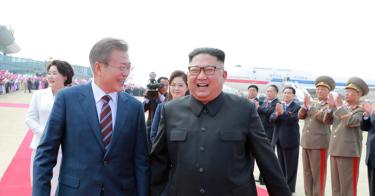It’s an unhappy fact that sometimes in international relations it is the actions of your allies—no matter how well-intentioned—that you have to be more concerned about than the actions of your enemies.
This is part of what policymakers call: “alliance management.”
It is getting to be a problem with our Asian ally, South Korea. Seoul seems to be pushing for a drastic softening of the current hard-nosed approach toward Pyongyang over the issue of denuclearization.
At last month’s summit between South Korea’s President Moon Jae In and North Korea’s Chairman Kim Jong Un, Seoul offered up a significant number of concessions to Pyongyang.
South Korea’s sanction-easing proposals, which run counter to U.S. law and U.N. Security Council resolutions, included (re)opening Kaesong Industrial Park in North Korea and reconnecting rail and road links between North and South Korea.
On the security front, South and North Korea agreed to (among other initiatives) create “buffer” and “no fly” zones and remove land mines along the Demilitarized Zone (DMZ), which has served as their de facto border since the Korean War armistice in 1953.
That was last month.
This month, it’s being reported that Seoul wants to offer a “peace declaration” to Pyongyang, seemingly ending hostilities on the Korean Peninsula, in exchange for the dismantlement of the North’s infamous Yongbyon nuclear facility.
Seoul would likely argue that these steps with Pyongyang would break the “stalemate” in U.S.-North Korea nuclear negotiations, demonstrate acts of good will and faith and serve as confidence and security building measures.
That sounds reasonable enough, but is it?
It certainly is from the perspective of North and South Korea. The Moon administration has long wanted to reduce pressure on Pyongyang, taking a page from the “ Sunshine Policy ” playbook of former South Korean President Kim Dae Jung.
While easing economic pressure on North Korea is troubling, a “peace declaration” between the United States and North Korea at this point in these difficult negotiations—even if not an official treaty—is more so.
Even if it is in exchange for the (more-than-once partially dismantled) Yongbyon nuclear facility.
An end-of-hostilities agreement could pave the way for a panoply of measures ending punitive economic sanctions, as South Korea has already proposed. It might also include ending current United Nations sanctions imposed on Pyongyang over its nuclear and ballistic missile programs.
North Korea would certainly argue that now that the war is “over,” there is no need for the United States to have sanctions on the regime at all, some of which stretch back to the beginning of the Korean War in 1950.
Moreover, though already accused of sanctions-busting behavior in a U.N. report, Russia and China could take more license than they already have to prop up the North Korean regime economically, especially considering difficult relations with the United States.
If the United States were to ease sanctions, leading to a reduction in economic pressure on North Korea, the incentives for Pyongyang to go further along the path toward denuclearization are diminished.
Moreover, reimposing multilateral sanctions after prematurely lifting them could be very tough. The Iran nuclear deal is a perfect example of that, with a number of the signatories seeking to preserve the Joint Comprehensive Plan of Action ( JCPOA) and resisting the United States’ reimposition of sanctions.
That is not a position Washington should want to be in.
In addition, the signing of a peace treaty could also lead to North Korean demands for the withdrawal of the 28,000-plus U.S. forces currently stationed in South Korea to leave the Korean Peninsula since hostilities have seemingly ended.
Pyongyang would also likely link it to the nuclear negotiations.
It is also certainly possible that public opinion in South Korea could shift significantly in the aftermath of a peace declaration, compelling Seoul to request Washington to remove American forces—and even end the mutual defense treaty.
In addition, public opinion in the United States, including in the Congress, could embrace the same sentiment and advocate that the Pentagon bring home U.S. forces from the Korean Peninsula—now that “peace” has broken out after 65 years of “conflict.”
Though South Korean forces are quite capable, absent U.S. forces on the Peninsula, a security vacuum could ensue that could tempt North Korea to try to reunify the two Koreas under its own terms—which would almost certainly include another Korean war.
Returning U.S. forces to Korea under those conditions would be suboptimal—to say the least.
All of these possible scenarios serve as good reasons to wait on a peace declaration (or a peace treaty) until the conditions for stability and security on the Korean Peninsula are a reality—and not just an aspiration.
American and South Korean soldiers have long talked about fighting “shoulder to shoulder.” That long-standing military tradition must also apply to diplomacy, too, where the United States and South Korea are stronger when in step on policy than not.
This piece originally appeared in the National Interest



